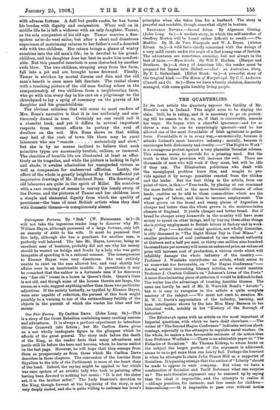NOVELS.
CHILDREN'S CHILDREN.t THIS interesting volume, if it does not, inaugurate a new departure in fiction, is at any rate an example of artistic collaboration as unfamiliar as it is agreeable. Illustrated novels are common enough, but nine times out of ten the efforts of the artist fail to satisfy the requirements of the reader, whatever may be the verdict of the author. Of late years efforts have been occasionally made to supply the place of the pencil with the camera, and we have seen more than one novel illustrated by photographs of living figures, posed singly or in groups. Where landscape is concerned, the result may be pleasing enough ; but it cannot be honestly said that it is otherwise illuminative. The nearest approach to the ideal would, of course, be made by the author-artist; but that combination rarely occurs, and, when it does, the two talents are never on an equality. The case of Thackeray will at once recur in support of this view, for while his drawings in the grotesque vein--e.g., The Rose and the Bing—established a perfect harmony with his text, he soon realised his incapacity to do justice to his more ambitious work, and preferred to rely on the assistance of Doyle and Walker. Du Maurier may be regarded as the exception that proves the rule; but Peter Ibbetson and Trilby, for all their ingenuous charm, cannot be seriously considered as masterpieces. Short of the combination of both roles in the same person, it would be difficult to imagine a happier form of collaboration in this field than that exemplified in the volume before us, where husband and wife have joined forces, literary and pictorial, in the effort to record an episode in the "simple annals of the poor." The scene, so we gather from general indications rather than any specific reference, is laid on the South Downs within easy range of the sea, and the dramatis personae of this tragic idyll are without exception of the peasant or small farmer class. Jacob Pyrah, the central figure, is an aged farmer whose life has been a long, but not ignoble, struggle • Housing Up to Date. By Alderman Thompson. London: P. S. King. [3s. 6d.] Chittlren's Children. By Gertrude Bone. With Drawings by bluirhead Bone. London: Duckworth and Co. [66.3
with adverse fortune. A dull but gentle rustic, he has borne his burden with dignity and resignation. When well on in middle life he is left a widower with an only daughter, Tamar, as the sole companion of his old age. Tamar marries a fine- spoken ne'er-do-weel sailor, but after a short and disastrous experience of matrimony returns to her father's roof a deserted wife with two children. Her return brings a gleam of wintry sunshine into the old man's life ; he is devoted to his grand- children, and his daughter does her best to make him comfort- able. But this peaceful interlude is soon disturbed by another rude blow. The two children, straying away from the farm, fall into a pit and are brought home drowned. Finally, Tamar is stricken by mortal disease and dies, and the old man's hearth is once more left desolate. The recital closes with a touching picture of the old man finding solace in the companionship of two children from a neighbouring farm, who go with him every day in his cart on a pilgrimage to the churchyard to lay a sprig of rosemary on the graves of his daughter and his grandchildren.
The obvious criticism that will occur to most readers of Mrs. Bone's narrative is that it is too uniformly and con- tinuously dismal in tone. Certainly no one could call it a cheerful book, and yet it differs in several important respects from recent efforts to portray the soul of dwellers on the soil. Mrs. Bone shows us that within easy hail of the rush of town life there may be rural
labourers who are "remote melancholy and slow," but she is by no means inclined to believe that such primitive types are necessarily brutish, callous, or immoral. The charities of humble life are illustrated at least as effec- tively as its tragedies, and while the picture is lacking in light and shade, it awakes admiration for unexpected virtues as well as compassion for undeserved affliction. Lastly, the effect of the whole is greatly heightened by the unaffected yet impressive drawings of Mr. Muirhead Bone. His drawings of old labourers are quite in the spirit of Millet. He contrives with a raze economy of means to convey the lonely sweep of the Downs, and the pictures of Tamar and her children have a simple and elemental dignity from which the quality of prettiness—the bane of most British artists when they deal with domestic themes—is conspicuously absent.





















































 Previous page
Previous page